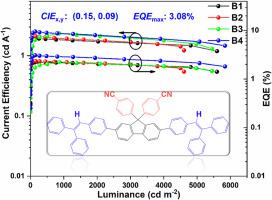High-efficiency deep-blue electroluminescence based on a fluorene derivative of AIEEgen containing triphenylethene
IF 3.6
3区 物理与天体物理
Q2 OPTICS
引用次数: 0
Abstract
This study details the synthesis and application of a novel blue hybridized local and charge-transfer (HLCT) emitter, 2TriPEF2CN, which integrates aggregation-induced enhanced emission (AIEE) characteristics with the “hot exciton” mechanism for high-efficiency deep-blue electroluminescence. The compound 2TriPEF2CN was designed with a fluorene core, electron-withdrawing p-cyanophenyl groups, and aggregation-induced emission (AIE)-active triphenylethene (TriPE) units. Theoretical calculations revealed that the twisted molecular configuration and the presence of the electron-withdrawing group effectively suppressed intermolecular aggregation and facilitated high-energy triplet utilization through the hRISC process. This unique molecular design endows the compound with AIEE and desirable photophysical properties, including a high photoluminescence quantum yield (Φ) of 40 % in the solid state and a short fluorescence lifetime of 0.9 ns. Based on 2TriPEF2CN, non-doped and doped organic light-emitting diodes (OLEDs) were fabricated. The non-doped OLED exhibited a modest external quantum efficiency (EQE) of 1.22 %, a maximum luminance (Lmax) of 3730 cd m−2, a maximum current efficiency (ηc,max) of 1.68 cd A−1, and a maximum power efficiency (ηp,max) of 0.79 lm W−1, which are acknowledged to be insufficient for practical display applications. In contrast, the doped OLEDs demonstrated distinct blue-shifted emission spectra with the Commission Internationale de l'Éclairage (CIEx,y) coordinate of (0.15, 0.09) and higher efficiencies, with the 20 % doped device achieving an EQEmax of 3.08 %, a ηc,max of 2.51 cd A−1, a ηp,max of 1.07 lm W−1, and a Lmax of 5839 cd m−2. All doped devices showed minimal efficiency roll-offs even at a luminance of 1000 cd m−2. This work offers a viable approach to constructing efficient deep-blue HLCT emitters by modifying fluorene derivative with AIE group triphenylethene.

基于含三苯乙烯的AIEEgen芴衍生物的高效深蓝色电致发光
本研究详细介绍了一种新型蓝色杂化局部和电荷转移(HLCT)发射器2TriPEF2CN的合成和应用,该发射器将聚集诱导增强发射(AIEE)特性与“热激子”机制结合在一起,实现了高效的深蓝色电致发光。化合物2TriPEF2CN具有芴核、吸电子的对氰苯基和聚集诱导发射(AIE)活性三苯乙烯(TriPE)单元。理论计算表明,扭曲的分子构型和吸电子基团的存在有效地抑制了分子间聚集,促进了hRISC过程中高能三重态的利用。这种独特的分子设计使该化合物具有AIEE和理想的光物理性能,包括在固态下高达40%的光致发光量子产率(Φ)和0.9 ns的短荧光寿命。基于2TriPEF2CN制备了非掺杂和掺杂有机发光二极管(oled)。未掺杂OLED的外量子效率(EQE)为1.22%,最大亮度(Lmax)为3730 cd m−2,最大电流效率(ηc,max)为1.68 cd a−1,最大功率效率(ηp,max)为0.79 lm W−1,但被认为不足以用于实际显示应用。相比而言,掺杂的oled表现出明显的蓝移发射光谱,其国际委员会Éclairage (CIEx,y)坐标为(0.15,0.09),效率更高,其中掺杂20%的器件的EQEmax为3.08%,ηc为2.51 cd a−1,ηp为1.07 lm W−1,Lmax为5839 cd m−2。所有掺杂器件即使在1000 cd m−2的亮度下也显示出最小的效率滚降。本研究为用AIE基三苯乙烯修饰芴衍生物来构建高效的深蓝HLCT发光体提供了一种可行的方法。
本文章由计算机程序翻译,如有差异,请以英文原文为准。
求助全文
约1分钟内获得全文
求助全文
来源期刊

Journal of Luminescence
物理-光学
CiteScore
6.70
自引率
13.90%
发文量
850
审稿时长
3.8 months
期刊介绍:
The purpose of the Journal of Luminescence is to provide a means of communication between scientists in different disciplines who share a common interest in the electronic excited states of molecular, ionic and covalent systems, whether crystalline, amorphous, or liquid.
We invite original papers and reviews on such subjects as: exciton and polariton dynamics, dynamics of localized excited states, energy and charge transport in ordered and disordered systems, radiative and non-radiative recombination, relaxation processes, vibronic interactions in electronic excited states, photochemistry in condensed systems, excited state resonance, double resonance, spin dynamics, selective excitation spectroscopy, hole burning, coherent processes in excited states, (e.g. coherent optical transients, photon echoes, transient gratings), multiphoton processes, optical bistability, photochromism, and new techniques for the study of excited states. This list is not intended to be exhaustive. Papers in the traditional areas of optical spectroscopy (absorption, MCD, luminescence, Raman scattering) are welcome. Papers on applications (phosphors, scintillators, electro- and cathodo-luminescence, radiography, bioimaging, solar energy, energy conversion, etc.) are also welcome if they present results of scientific, rather than only technological interest. However, papers containing purely theoretical results, not related to phenomena in the excited states, as well as papers using luminescence spectroscopy to perform routine analytical chemistry or biochemistry procedures, are outside the scope of the journal. Some exceptions will be possible at the discretion of the editors.
 求助内容:
求助内容: 应助结果提醒方式:
应助结果提醒方式:


